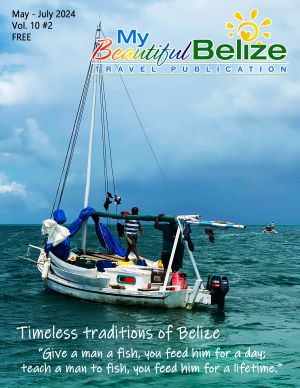November 19th is a great day of celebration in Belize, as we honor the Garifuna and their culture. Let us share a few basic but important details about this amazing cultural group, who make such an impact in our society.
THOMAS VINCENT RAMOS

In 1941, Belizean civil rights activist, Thomas Vincent Ramos created the Garifuna Settlement Day holiday to honor and celebrate the arrival of the Garifuna people on Belize’s shores on November 19, 1802. The date was recognized as a public holiday in the southern districts of Belize in 1943, and declared a national holiday in 1977 by the Government of Belize. Ramos was also a schoolteacher and a visionary leader, founder of the Carib Development and Sick Aid Society and later the Carib International Society.
YURUMEIN
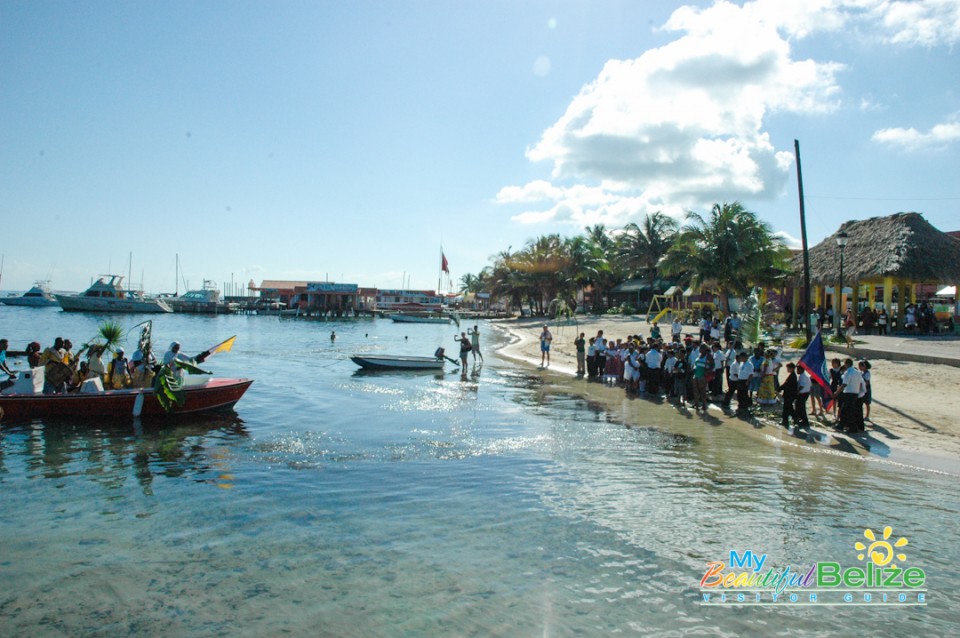 The re-enactment of the Garinagu trails as they journeyed in dugout canoes from St. Vincent to Roatan, Honduras then to Belize is called Yurumein, which means ‘homeland’. It is a lively procession with drumming and singing, and every dawn of November 19th, municipalities throughout Belize enjoy this colorful re-enactment, rain or shine.
The re-enactment of the Garinagu trails as they journeyed in dugout canoes from St. Vincent to Roatan, Honduras then to Belize is called Yurumein, which means ‘homeland’. It is a lively procession with drumming and singing, and every dawn of November 19th, municipalities throughout Belize enjoy this colorful re-enactment, rain or shine.
THE GARIFUNA FLAG
 Consisting three horizontal stripes – black, white and yellow – in that order – starting from the top – the Garifuna flag has been accepted internationally as the flag of the Garifuna Nation. These colors are synonymous with the Garifuna identity.
Consisting three horizontal stripes – black, white and yellow – in that order – starting from the top – the Garifuna flag has been accepted internationally as the flag of the Garifuna Nation. These colors are synonymous with the Garifuna identity.
DRUMS
Drums are the ‘heartbeat’ of the Garifuna culture – there is just no denying this. When that sound fills the air, one’s soul is called to attention, and our feet shuffle to find the source.
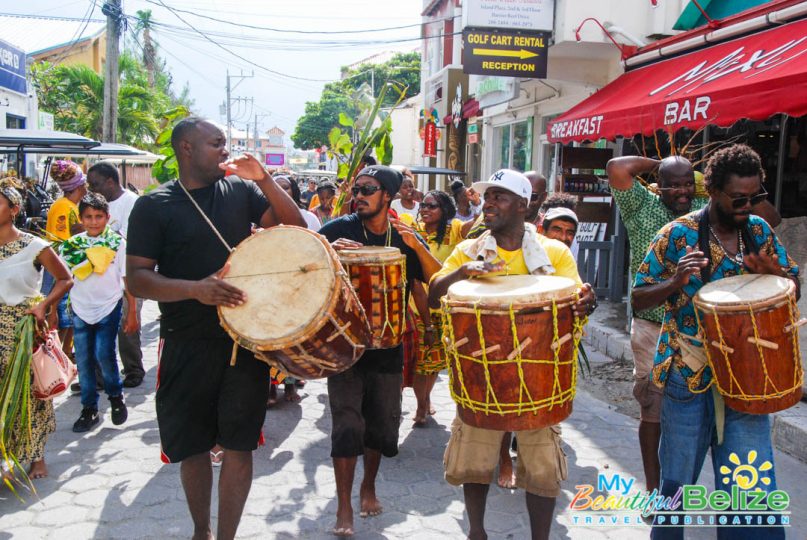 There are two main types of drums, the Primero and the Segundo, differentiated only by their size. The Primero has a smaller diameter, producing a higher pitch, while the Segundo’s larger diameter produces that heavy bass sound. The bass drummer provides the beat of the song with his consistent rhythm, while the Primero drummer is responsible for the faster rhythms.
There are two main types of drums, the Primero and the Segundo, differentiated only by their size. The Primero has a smaller diameter, producing a higher pitch, while the Segundo’s larger diameter produces that heavy bass sound. The bass drummer provides the beat of the song with his consistent rhythm, while the Primero drummer is responsible for the faster rhythms.
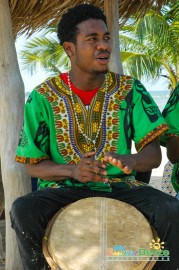 “Drums of my Fathers
“Drums of my Fathers
Rumbling in my bones –
Drums of my Fathers
Beating in my mind –
…
Drums of my Fathers
Capturing my soul –
Words of my Fathers
Tumbling from my mouth…”
(Roy Cayetano)
JANKUNU
A cultural masked dance, the Jankunu (Wanaragua) incorporates vibrant costumes and masks, along with intricate footwork, drumming and much singing to tell the tales of the struggles of their ancestors. The masks are a major part of the satirical dance, as the men dress in English colonial garb and wear a white face mask, mocking the English slave master.

It is exclusively for males who dance and play drums. Females are allowed, but only as singers. In the old days, the dance was reserved for the rest days of the laborers, mostly Christmas night or New Year’s Eve. In Belize, the Jankunu is a big Christmas tradition in the culture capital, Dangriga Town, Stann Creek District.
EREBA (CASSAVA BREAD)
Cassava is a staple used in multiple ways, and the Garifuna culture has cornered the Ereba (cassava bread) market.
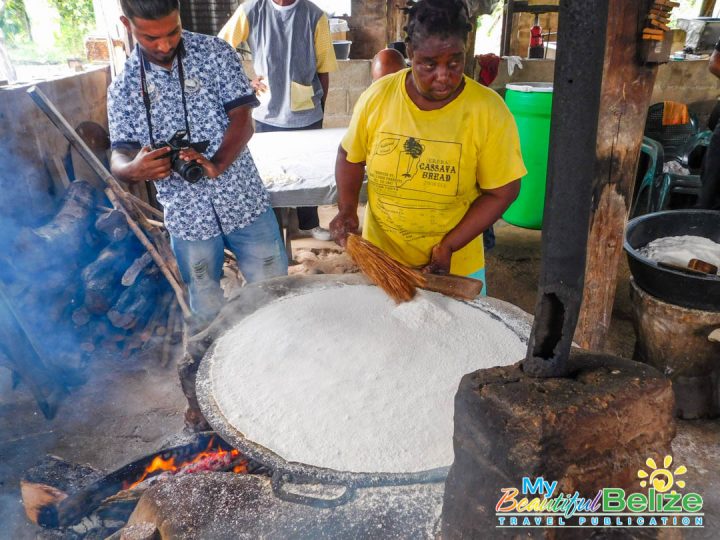 Processing this starchy goodness often sees farmers heading to their fields by 6AM, uprooting the tuber to be peeled, washed and grated, then dried, drained, sieved, and baked over a hot comal (special flat pan for baking) on high heat. It is a community-driven staple, as it requires integral elements of the Garifuna culture: teamwork and soul.
Processing this starchy goodness often sees farmers heading to their fields by 6AM, uprooting the tuber to be peeled, washed and grated, then dried, drained, sieved, and baked over a hot comal (special flat pan for baking) on high heat. It is a community-driven staple, as it requires integral elements of the Garifuna culture: teamwork and soul.
HUDUT
A classic staple of Garifuna tables all over Belize, Hudut is a delicious combination of plantains, fish, and coconut. While similar to coconut-based fish stews worldwide, Hudut is separated from the rest by its flavors enhanced with cilantro, oregano and okra.

Paired with fu-fu (boiled and mashed plantains) Hudut takes on an even more unique route to stand out from the rest. Green and ripe plantains are combined and mashed in a traditional mata bowl using a hahna stick, and it is the side dish that accompanies the coconut-based fish stew. If you ever get a chance to try this dish, do so!

This year’s theme is “Garinagu: úara, here; awansera asta lidan liderenouga.” (Garinagu: United and Strong, moving forward despite challenges). In the era of Covid-19, we will miss the food as well as the singing, drumming and dancing that signals the ushering in of a new year of celebration. However, despite challenges, our Garifuna people move ever forward, ensuring their legacy and culture remains vibrant and alive in the minds of all Belizeans. Happy Garifuna Settlement Day!


